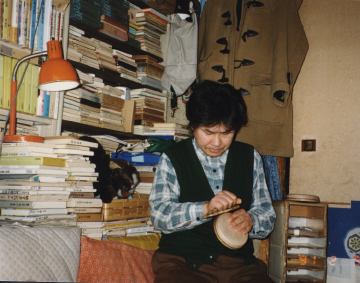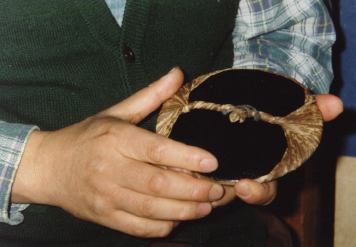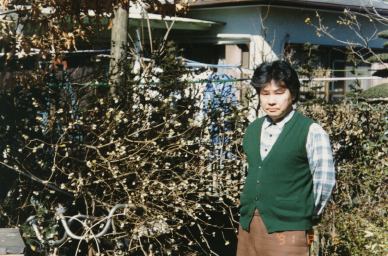Mr. Kikuo Gosho, baren maker
I was starting to get a bit frustrated. Perhaps I
would not be able to live up to the boast I had made on the
telephone, "Of course I'll be able to find your house, don't worry
...." From my home in Hamura to Shimo-fujisawa in Saitama had taken
just one hour by bicycle, and it had seemed that there was going to
be no problem. But I had now been wandering around the town in ever
increasing frustration trying to locate the house, and in my fear of
being late I was ready to swallow my pride and ask directions. I
pointed my bicycle down a narrow path where a woman was sweeping
leaves, and hesitantly asked her, "Sumimasen, Shimo-fujisawa no yon
hyaku hachi wa doko ni arimasu ka?" Of course, that turned out to be
her house number, and this was my destination. It had taken me a hour
to get to their town, and another hour just to find their
house.
 I was visiting Mr. Kikuo Gosho to see something
of his work, and to place an order for one of his hand-made barens,
the tool used for rubbing the printing paper over the woodblocks. Up
to this point I had been using a varied selection of barens, mostly
student-grade tools that I had obtained from art supply stores. Some
of these had been quite expensive - about 15,000 yen, but all were
less than adequate, and I was growing increasingly frustrated with
using them. There is a well-known saying to the effect that it is a
poor workman who blames his tools for bad work, but nonetheless, you
don't see many professionals using toy tools. Some professional
printmakers had recommended I come and see Gosho-san. This visit was
long overdue.
I was visiting Mr. Kikuo Gosho to see something
of his work, and to place an order for one of his hand-made barens,
the tool used for rubbing the printing paper over the woodblocks. Up
to this point I had been using a varied selection of barens, mostly
student-grade tools that I had obtained from art supply stores. Some
of these had been quite expensive - about 15,000 yen, but all were
less than adequate, and I was growing increasingly frustrated with
using them. There is a well-known saying to the effect that it is a
poor workman who blames his tools for bad work, but nonetheless, you
don't see many professionals using toy tools. Some professional
printmakers had recommended I come and see Gosho-san. This visit was
long overdue.
The house is small, and there is no room for a
special workshop. Gosho-san's work is inseparable from his family
life. He works on the floor in the center of a six mat room, flanked
by his two children's school desks, towering bookshelves, and the
usual assortment of Japanese wardrobes. As I enter the house, and
walk sideways down a narrow passage, I can see that every inch of
space off to each side is jammed with his vast collection of
materials related to printmaking: books, tools and prints. He
obviously lives for 'hanga'.
 His work just as conveniently can be summed up
with one word: 'take', the Japanese bamboo (pronounced like the
drink: 'sake'), for it is this versatile plant which provides the
material necessary for making his barens. A printmaker's baren has
three main components, a tight coil made of literally thousands of
short thin strips peeled from the outer surface of a special type of
bamboo leaf; a backing disk made of dozens of layers of tissue-thin
Japanese 'washi', pasted together over nearly a month at the snail's
pace of one sheet per day; and finally the covering, a specially
prepared, tightly wrapped leaf from yet another kind of bamboo. This
'formula' was developed gradually over a period of some centuries,
and has proved to be so well matched to the printmaker's needs that
no substitutes have ever been able to replace it. Modern Japanese
entrepreneurs have tried dozens of alternatives: molded plastic, rows
of tiny metal balls mounted in teflon, and many other ingeneous
devices. None of them do the job as well as the traditional
materials. Bamboo remains 'king'.
His work just as conveniently can be summed up
with one word: 'take', the Japanese bamboo (pronounced like the
drink: 'sake'), for it is this versatile plant which provides the
material necessary for making his barens. A printmaker's baren has
three main components, a tight coil made of literally thousands of
short thin strips peeled from the outer surface of a special type of
bamboo leaf; a backing disk made of dozens of layers of tissue-thin
Japanese 'washi', pasted together over nearly a month at the snail's
pace of one sheet per day; and finally the covering, a specially
prepared, tightly wrapped leaf from yet another kind of bamboo. This
'formula' was developed gradually over a period of some centuries,
and has proved to be so well matched to the printmaker's needs that
no substitutes have ever been able to replace it. Modern Japanese
entrepreneurs have tried dozens of alternatives: molded plastic, rows
of tiny metal balls mounted in teflon, and many other ingeneous
devices. None of them do the job as well as the traditional
materials. Bamboo remains 'king'.
But back to Gosho-san, working on a customer's
order. The preparation has been done, the thousands of tiny bamboo
strips needed to make the coil all sliced to size and carefully
moistened. He sits in front of a low wooden frame and starts lacing
the strips together, four at a time. The first ones are tied to a
loop on the frame, and then a lightning fast twist, twist, twist,
produces the first few centimeters of delicate woven bamboo 'rope'.
As the strips in his hand become shorter, new ones are fed into the
work. His hands are a literal blur, and I can't possibly see what he
is doing. I try counting how many fingers would be needed just to
simply hold the growing rope and the clutch of thin strips. I give up
at 12. A typical baren will contain 18 meters of this delicate
creation, with some using much more. It will take him many, many
hours to produce the necessary length. His fingers are covered with
areas of tough hard skin at the points where he rolls the strips into
tight spirals.
Work on the backing disc takes place
simultaneously. Each day, a filmy sheet of washi is added to those
glued onto a carved template on previous days. When the required
number are in place, a covering layer of silk is pasted over the
stack, and this is topped with rich black Japanese lacquer, a finish
just like that which we see on expensive laquerware. This month, he
will make a total of six of these beautiful tools, each of which will
go to a highly appreciative customer, who will treasure it for a
lifetime.
After some discussion of size, and details like
the number of windings in the coil, I place an order for him to make
me one. The price will be 50,000 yen, which although it sounds
expensive, is actually a bargain considering the amount of work I
will be able to do with this tool over the coming years. He promises
that it will be ready in about six weeks, and I make my way home, a
little more directly than I came.
...
His phone call finally comes (I had been sleeping
by the telephone!), and Michiyo and I cycle over to pick up the
finished baren. After nine years of struggling with poor tools - I
have never felt anything like it. This is the way to really feel
appreciation for a good tool: to go through a training period with
'average' equipment, and only when you have developed some feeling
for 'how it's done', to step up and receive at last your 'real' tool.
This baren will be my partner for many years to come. All the prints
you have been receiving from me this past year have been printed by
Gosho san's handiwork.
 The professional printers I visit occasionally in
Tokyo all have quite a collection of barens, thin ones, thick ones,
with heavy or light coils, etc. They reach for the one that best
suits the particular job at hand. In the future (near, I hope), when
my skills have developed somewhat further (and when my budget
allows), I will be back here once more, to watch Gosho san's flying
fingers weave some more of his magic bamboo rope. If smooth deep
colours are finally becoming apparent in my prints, it is in large
part due to the hours he spends crouching over his work, endlessly
twisting, twisting, twisting, those little pieces of the amazing
bamboo. Gosho san, for your hard work and dedication, thank you very
much.
The professional printers I visit occasionally in
Tokyo all have quite a collection of barens, thin ones, thick ones,
with heavy or light coils, etc. They reach for the one that best
suits the particular job at hand. In the future (near, I hope), when
my skills have developed somewhat further (and when my budget
allows), I will be back here once more, to watch Gosho san's flying
fingers weave some more of his magic bamboo rope. If smooth deep
colours are finally becoming apparent in my prints, it is in large
part due to the hours he spends crouching over his work, endlessly
twisting, twisting, twisting, those little pieces of the amazing
bamboo. Gosho san, for your hard work and dedication, thank you very
much.